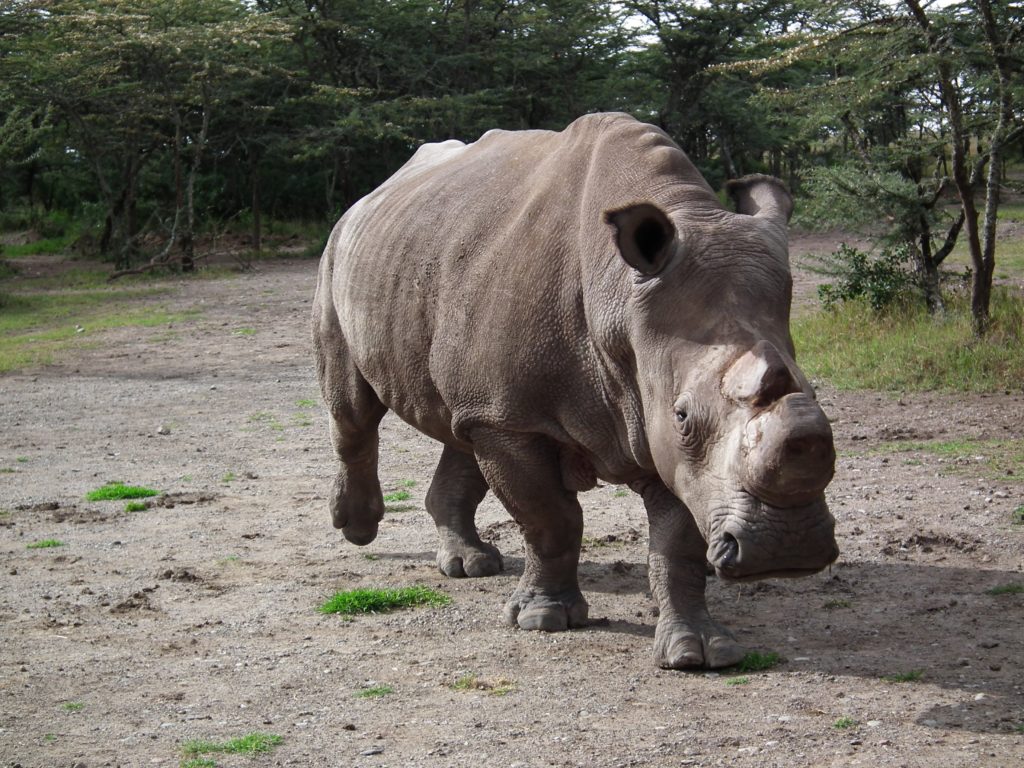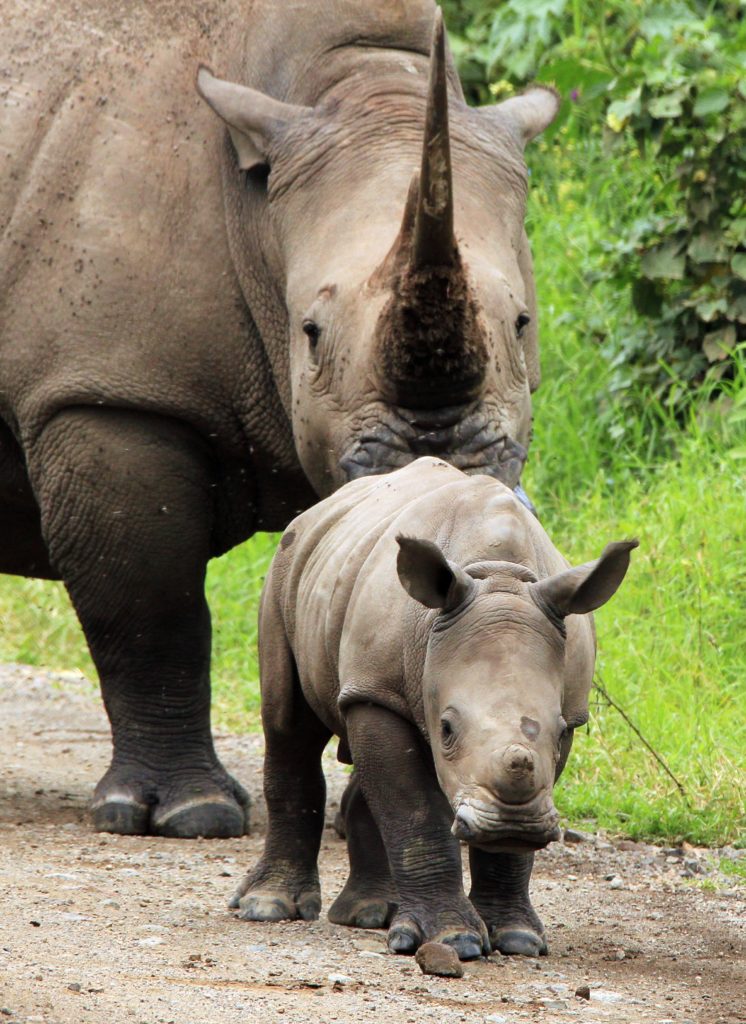In April of 2017 a profile appeared on the dating app Tinder. Describing himself as “One of a kind”, the poster was 43 years old, not in great physical shape, and yet so sought after he required around the clock body guards. His name was Sudan, and he was the last living male northern white rhino. His keepers at the Ol Pejeta Conservancy in Kenya weren’t expecting Sudan to find love. They were hoping to raise awareness of the species’ dire situation and money for the research and development of an in vitro fertilization (IVF) method for rhinos.

Northern white rhinos used to range over all or parts of Uganda, Sudan, Chad, the Democratic Republic of the Congo and the Central African Republic. In the 1960s there were an estimated 2,360 northern white rhinos left in the wild (1). Civil unrest in the region made conservation difficult, and by 2003 poaching and other pressures had reduced the number of northern white rhinos living in the wild to four individuals living in the Garamba National Park in the Democratic Republic of the Congo. There has been no sign of that wild population since 2007 (2), and they are considered extinct in the wild as of 2008.
Count Down to Extinction?
In 2008 there were eight northern white rhinos living in captivity around the world. Despite breeding efforts at the San Diego Zoo Safari Park and the Dvůr Králové Zoo in the Czech Republic, only two female northern white rhinos reproduced in captivity, with a total of five Northern white rhinos being born in captivity between 1980 and 2000. In 2009, four of the remaining eight northern white rhinos, two males (Sudan and Suni) and two females (Najin and Futa), were transferred to the ol Pejeta Conservancy. Despite early hopes, scientist determined that neither Najin nor Futa were capable of conceiving or carrying a pregnancy to term (2). One of the males, Suni died there in 2014, and with the death of a female at the San Diego Zoo in 2015, Sudan and his two female companions became the only living members of their species.
Hunted Even in Captivity
Rhinoceroses have been hunted for centuries for their horns. Some cultures believe that the rhino horn has medicinal properties. Despite conservation efforts, there is still a strong demand for these horns, and as a result these animals are vulnerable to poaching in the wild. Even captive animals are targets, as evidenced by the 2017 killing of a 4-year old southern white rhino in a wildlife park near Paris. The poachers used a chain saw to removed one horn and partially remove the second. That this animal was killed while living behind a fence and several secure doors in a park that was monitored by around the clock staff and video surveillance speaks to the determination and sophistication of the criminal organizations that traffic illegal animal products.
And Then There Were Two
At the ol Pejeta Conservancy the northern white rhinos are protected by armed guards around the clock. Armed guards can’t protect them from age, illness or infection however, and Sudan died on March 20, 2018. He was 45 years old and had developed a bacterial infection in his right back leg. For some, Sudan’s death signaled the extinction of the northern white rhino. The only possibility for saving the species now is IVF, and with the two remaining females unable to sustain a pregnancy, the only hope for producing a baby northern white rhino is IVF using a surrogate female (most likely from the closely related southern white rhino (sub)species). This is a pretty high hurdle to clear. Not only is there no current IVF protocol for rhinos, developing one will take time and money. With his Tinder profile, conservation scientists and Sudan’s keepers were hoping to raise 9 million dollars to fund the research through the “swipe right to save this endangered rhino” Tinder campaign. Unfortunately, Sudan’s profile didn’t generate the interest or public support that everyone had hoped for.
A Vision for the Future
Conservation scientists still hold on to hope that the northern white rhino can be saved, or returned, from extinction. In 2015 a group of scientists met in Vienna, Austria to discuss possible options for the northern white rhino. The meeting, “Conservation by Cellular Technologies” was to develop a plan that might one day lead to a viable population of northern white rhinos (2). Their vision is to use cellular technologies and resources collected from northern white rhinos before their deaths as well as those from the two remaining live individuals, to create both natural and artificial gametes. Artificial gametes will allow them to create the most genetic diversity. These gametes could be used to product in vitro embryos, which in turn would be implanted into a surrogate female. The long-term goal would be to produce a viable and self-sustaining population of northern white rhinos.
A Reason to Hope
The realization of this vision is most likely decades down the road and relies on the use of southern white rhinos as surrogates. Fortunately the southern white rhino, once thought nearly extinct, has made a dramatic recovery. In fact the recovery of the white rhino is one of conservation’s greatest success stories.

In the late 1800s, the white rhino was believed to be extinct until a population of about 100 individuals was discovered 1895 in South Africa. Through a combination of protection and careful management, that number has grown to over 20,000 white rhinos living today. Clearly, time, protection and management can produce amazing results for critically endangered species. In the case of the northern white rhino, the question is did we notice their plight in time to save them?
References
- Emslie, R. and Brooks, M. (1999) African Rhino: Status survey and conservation action plan. Gland, Switzerland: IUCN.
- Saragust, J. et al. (2016) Rewinding the process of mammalian extinction. Zoo Biol. 35, 280–92.
Related Posts
Kelly Grooms
Latest posts by Kelly Grooms (see all)
- Discovery of Protein Involved in TDP-43 Cytoplasmic Re-Localization Points to Potential Gene Therapy for ALS and FTD - April 2, 2024
- Dynein Motor Proteins Could Be the Moving Power Behind Cancer Metastasis - February 16, 2024
- Cyanobacteria Identified as Cause of Elephant Mass Mortality Event - January 11, 2024
